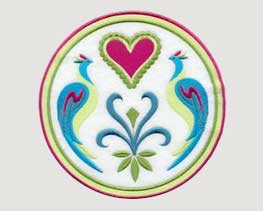
Embroidery just looks beautiful. So, given the choice, why not embroider?
How does embroidery work?
First, we take the digital file of your logo, your name, or whatever else you would like to embroider, and take it through a process called “digitizing,” which converts the file into instructions for the embroidery machine, including stitch count, stitch length, and thread color changes throughout the design.
Next, we mount your fabric onto an embroidery hoop that will hold the section to be embroidered flat and steady during the embroidery process. We use a stiff backing fabric to help the embroidery hold its shape well.
Once the fabric is mounted and the machine’s computer has access to your digitized file, we put in the final color instructions by telling the embroidery machine which needle to use for each color change within your file. The embroidery machine has 14 needles, each of which can be threaded with a different color of thread, which means we could embroider up to 14 different colors in one design.
An interesting note is that because this is the final step in the process, it allows us to change the color instructions on future embroidery orders. The possible color changes must be marked in the file. We can’t add those in later. But we can choose to use different colors than we used the first time around. We can also choose not to change colors but use all one color for the entire project. That kind of versatility comes in handy when you want to embroider the same artwork on items that are a variety of different colors that may clash with your original design.
Finally, we start sewing. The machine follows its programmed instructions on its own. We just watch it to make sure thread does not snag or break as it sews.
What are the limitations of embroidery?
Embroidery works best on stiff fabrics such as hats, jackets, towels, tablecloths, jeans, sturdy woven shirts, sweatshirts, sweatpants, hoodies and many blankets. It can also work well on polo shirts, as long as the fabric is thick enough to support using backing fabric to reinforce the embroidery’s foundation.
Embroidery is not a good option for thin fabrics or for very stretchy fabrics. Thin and stretchy fabrics do not work well with embroidery backing material because you can see it through the fabric after the embroidery is completed. Without the backing material to stabilize the project, the embroidery stitches pull too tight and pucker the fabric. Instead of embroidering thin or stretchy fabrics, we recommend using heat transfer vinyl or screen printing to personalize them. The finished product will look cleaner and more professional.
Embroidery files cannot be resized as regular digital files can. They can get slightly smaller or slightly bigger without looking odd, but a much larger area to be embroidered will require more stitches than a smaller area. This means that if you need your logo embroidered in significantly different sizes, you will need to have it digitized more than once. The good news is that digitizing only needs to happen once per size that you would like your art embroidered. We can use the same files over and over again for future orders as long as the logo or art to be embroidered stays the same size.
What is the timeline for embroidery?
Digitizing your file generally takes 2-3 business days.
Once we have an approved digitized file, the necessary thread, and your items to embroider, embroidery can usually be completed within 3-5 business days.
Orders with large quantities and/or a large embroidery area may require more time. If you have a large order, please call us at least two weeks before you need your order completed to ensure we can meet your deadline.
As with all of our printing, if you need an embroidery order completed on a tighter schedule than our standard schedule, please call us. We may be able to meet your deadline, and we would love to do so if we can.
Fill out the form below to get started: